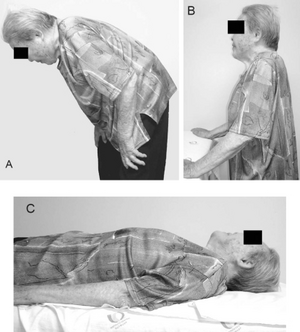Camptocormia
Camptocormia is characterised by marked flexion (greater than 45 degrees) of the thoracolumbar spine that increases during the day that can be caused by several different diseases.
History and Terminology
First described by Earle in 1815 and by Brodie in 1837. The term comes from the Greek words "to bend" (kamptō) and "trunk" ("trunk").
Aetiology
Camptocormia can have a neurological or muscular origin
- Parkinson's disease: the most common cause (two third).
- Other parkinsonian syndromes
- Dystonia
- Vascular lenticular lesions
- Muscular disorders
- Rheumatologic disorders.
Epidemiology
In those with Parkinson's disease and camptocormia there is a male predominance, older age, longer duration of disease, and autonomic symptoms.[1]
Clinical Features
As the day goes on or during walking there is a progressive marked flexion of the thoracolumbar spine. It is relieved by sitting and lying supine. It can also be relieved volitionally by extending the trunk when the patient leans against a wall. There may be associated lateral deviation of the trunk. In two thirds of patients there is a lumbar or thoracolumbar scoliosis.[1]
Further Reading
References
- ↑ 1.0 1.1 Benatru, I.; Vaugoyeau, M.; Azulay, J.-P. (2008-12). "Postural disorders in Parkinson's disease". Neurophysiologie Clinique = Clinical Neurophysiology. 38 (6): 459–465. doi:10.1016/j.neucli.2008.07.006. ISSN 0987-7053. PMID 19026965. Check date values in:
|date=(help)
Literature Review
- Reviews from the last 7 years: review articles, free review articles, systematic reviews, meta-analyses, NCBI Bookshelf
- Articles from all years: PubMed search, Google Scholar search.
- TRIP Database: clinical publications about evidence-based medicine.
- Other Wikis: Radiopaedia, Wikipedia Search, Wikipedia I Feel Lucky, Orthobullets,



